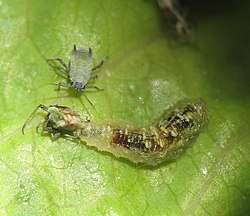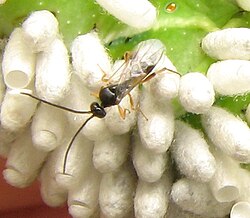
Back Natuurlike plaagbeheer Afrikaans مكافحة حيوية للآفات Arabic Control biològic de plagues Catalan Biologický boj Czech Biologisk bekæmpelsesmiddel Danish Biologische Schädlingsbekämpfung German Biologia lukto kontraŭ plagoj Esperanto Control biológico Spanish Biotõrje Estonian کنترل بیولوژیک آفات Persian


Biological control or biocontrol is a method of controlling pests, whether pest animals such as insects and mites, weeds, or pathogens affecting animals or plants by using other organisms.[1] It relies on predation, parasitism, herbivory, or other natural mechanisms, but typically also involves an active human management role. It can be an important component of integrated pest management (IPM) programs.
There are three basic strategies for biological control: classical (importation), where a natural enemy of a pest is introduced in the hope of achieving control; inductive (augmentation), in which a large population of natural enemies are administered for quick pest control; and inoculative (conservation), in which measures are taken to maintain natural enemies through regular reestablishment.[2]
Natural enemies of insects play an important part in limiting the densities of potential pests. Biological control agents such as these include predators, parasitoids, pathogens, and competitors. Biological control agents of plant diseases are most often referred to as antagonists. Biological control agents of weeds include seed predators, herbivores, and plant pathogens.
Biological control can have side-effects on biodiversity through attacks on non-target species by any of the above mechanisms, especially when a species is introduced without a thorough understanding of the possible consequences.
- ^ Flint, Maria Louise; Dreistadt, Steve H. (1998). Clark, Jack K. (ed.). Natural Enemies Handbook: The Illustrated Guide to Biological Pest Control. University of California Press. ISBN 978-0-520-21801-7. Archived from the original on 15 May 2016.
- ^ Unruh, Tom R. (1993). "Biological control". Orchard Pest Management Online, Washington State University. Archived from the original on 6 December 2018. Retrieved 8 November 2017.